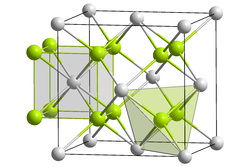Potassium telluride
 K+: __ Te2-: __
| |
| Identifiers | |
|---|---|
3D model (
JSmol ) |
|
| ChemSpider | |
ECHA InfoCard
|
100.032.039 |
| EC Number |
|
PubChem CID
|
|
| |
| |
| Properties | |
| K2Te | |
| Molar mass | 298.64 g/mol |
| Appearance | pale yellow powder, turns grey when exposed to air[1] |
| Melting point | 874 °C |
| Related compounds | |
Other anions
|
Potassium oxide Potassium sulfide Potassium selenide Potassium polonide |
Other cations
|
Lithium telluride Sodium telluride Rubidium telluride Caesium telluride |
Except where otherwise noted, data are given for materials in their standard state (at 25 °C [77 °F], 100 kPa).
| |
Potassium telluride is an inorganic compound with a chemical formula K2Te. It is formed from potassium and tellurium, making it a telluride.[2] Potassium telluride is a white powder. Like rubidium telluride and caesium telluride, it can be used as an ultraviolet detector in space. Its crystal structure is similar to other tellurides, which have an anti-fluorite structure.
Production
Tellurium will react with melting potassium cyanide (KCN) producing potassium telluride. It can also be produced by direct combination of potassium and tellurium, usually in liquid ammonia solvent:[3]
Reactions
Adding potassium telluride to water and letting the filtrate stand in air leads to an oxidation reaction that generates potassium hydroxide (KOH) and elemental tellurium:[3][4]
References
- Sangester J. and Pelton AD; Journal of Phase Equilibria, 1997, 18(4) p. 394.
- . Retrieved 2019-11-23.
- .
- ^ ISBN 978-3-13-179191-7.
- ISBN 978-5-87746-719-4


